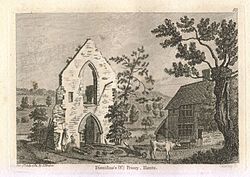
Mount Grace Priory is a monastery in the parish of East Harlsey, North Yorkshire, England. Set in woodlands within the North York Moors National Park, it is represented today by the best preserved and most accessible ruins among the nine houses of the Carthusian Order, which existed in England in the Middle Ages and were known as charterhouses.

Portswood is a suburb and Electoral Ward of Southampton, England. The suburb lies to the north-north-east of the city centre and is bounded by Freemantle, Highfield, Swaythling, St. Denys and Bevois Valley.
St Denys is a partially riverside district of Southampton, England, centred 1.5 miles (2.4 km) north north-east of the city centre facing variously Bitterne Park and quay across the River Itchen estuary. The river is here spanned in the mid-east extreme of the district by Cobden Bridge, one of five within the city's broad boundaries, six including the railway bridge 100 m south. It is separated from the city centre by the districts sometimes known as Bevois Valley and New Town, in turn.
Southwick Priory or Our Lady at Southwick was a priory of Augustinian canons founded in Portchester Castle on Portsmouth Harbour and later transferred 2 miles (3.2 km) north to Southwick, Hampshire, England. It ceased at the Dissolution of the Monasteries in 1538.

St. Botolph's Priory was a medieval house of Augustinian canons in Colchester, Essex, founded c. 1093. The priory had the distinction of being the first and leading Augustinian convent in England until its dissolution in 1536.

Shelford Priory is a former Augustinian Monastery located in the village of Shelford, Nottinghamshire, United Kingdom. The priory was founded by Ralph Haunselyn around 1160–80 and dissolved in 1536. Little remains of the original priory. Following dissolution it was granted to Michael Stanhope, and c.1600 Shelford Manor was constructed on the site. The manor was fortified and then partially destroyed during the English Civil War. The house was reconstructed c.1678, however, it was altered in the 18th and 19th centuries. It is now known as Shelford Manor and is a private residence.
Wherwell Abbey was an abbey of Benedictine nuns in Wherwell, Hampshire, England.
Breamore Priory was a priory of Austin canons in Breamore, Hampshire, England.
Poughley Priory was a priory of Austin Canons at Chaddleworth in the English county of Berkshire, located between Great Shefford and Leckhampstead.

Bradbourne Priory was a priory in Bradbourne, Derbyshire, England.

Gresley Priory was a monastery of Augustinian Canons regular in Church Gresley, Derbyshire, England, founded in the 12th century.

Leonard Stanley Priory was a priory in Gloucestershire, England. Over the years following the dissolution most of the buildings of the priory complex have been destroyed.
Hough Priory was a priory in Hough-on-the-Hill, Lincolnshire, England. The manor on which the priory of Hough was afterwards built was granted by Henry I to his abbey of St. Mary de Voto at Cherbourg, for Austin canons. The parent abbey itself at its foundation contained only an abbot and four canons, and the cell having no other endowment than the manor and church of Hough, was intended for the support of a prior with a single chaplain for his companion, to maintain divine service for the soul of the king and his family.
Priory of St. Thomas near Stafford was an Augustinian religious house near Stafford, Staffordshire, England. Founded sometime in approximately 1174, it was a surrendered to the Crown in 1538, during the Dissolution of the Monasteries.

Great Bricett Priory was a medieval monastic house in Great Bricett in Suffolk, England, the chapel of which is now in use as the Church of England parish church of St Mary and St Lawrence. Ralph FitzBrian and Emma his wife, about the year 1110, founded a priory for Austin canons at Bricett, which was dedicated to the honour of St Leonard. The foundation charter endowed the priory with the tithes of Bricett and of 'Losa' with its chapel, a moiety of the church of 'Stepla,' and the associated church of Stangate, Essex, in addition to various plots of land in the vicinity. The founder also gave to the canons a large garden on the south of the monastery and a smaller one on the east, and he ordained that whenever he was in Suffolk the canons were to act as his chaplains and to receive a tithe of his bread and beer. The priory of Bricett was claimed, early in the thirteenth century, as pertaining to the monastery of Nobiliac, in the diocese of Limoges and the Duchy of Berry. This claim was resisted, but in 1295 an agreement was arrived at favourable to the foreign house, whereby Bricett became an alien priory; this composition was renewed and confirmed by the Bishop of Norwich in the chapter house of Bricett, on 16 July 1310. In a long list of royal protections to religious houses in 1295, in return for bestowing on the king a tithe of their income, the priory of Bricett is described as a cell to the priory of 'Noblac in Lymoche's'.
Tandridge Priory was a priory in Surrey, England.
Sheen Friary later also known as Richmond Priory (1414-1539) was a friary in Surrey, England, restored as a national gathering of Carthusians by Maurice Chauncy at Sheen under Mary I of England during part of her reign from 1553 to 1558.
Longleat Priory was a priory near Warminster, Wiltshire, in the south of England. A short-lived priory was established and dissolved near to Longleat in the 12th century. The main priory was established before 1233 and was under the control of the Dean of Salisbury until its dissolution in 1529.

Sandleford Priory was a small Augustinian Priory, the remains of which now stand at Sandleford in the civil parish of Greenham in the English county of Berkshire.











